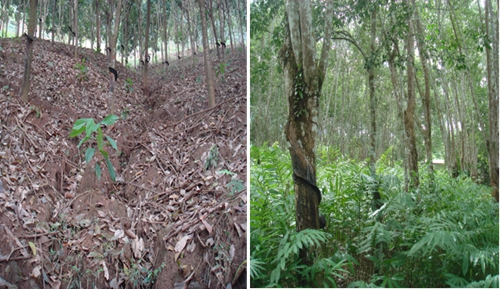Land degradation resulting from rubber monoculture is intensifying in Xishuangbanna. Rubber–based agroforestry systems serve as a promising solution, and various rubber–based agroforestry systems have been applied in practice. However, the soil physical conditions and soil hydrological processes of different agroforestry systems are still unclear.
Prof. LIU Wenjie and his team of Xishuangbanna Tropical Botanical Garden (XTBG) conducted a study to comprehensively consider soil physical conditions and hydrological processes in identifying the mechanism that allows for ideal water sharing in intercropping systems with rubber trees.
The researchers developed rubber (Hevea brasiliensis) monoculture (RM), rubber and Clerodendranthus spicatus agroforestry system (RCS), and rubber and Amomum villosum agroforestry system (RAV) from a degraded land which had similar backgrounds of terrain and management measures for 50 years in Xishuangbanna.
They applied conventional methods and conducted dye tracer experiments to measure the soil physical conditions and determine the water movement in soil, respectively.
Compared with rubber monoculture plantations, agroforestry systems (RAV, RCS) are more effective in using and managing water resources because of their multiple–layered canopies and ground cover.
Rubber monoculture plantations are characterized by single–layered canopy, small amount of ground cover, high soil bulk density, low hydraulic conductivity (Ks), serious soil splash erosion, poor soil structure, low field capacity, inflexible water supply mechanisms.
The agroforestry systems (RAV, RCS) could effectively decrease soil bulk density; enhance noncapillary and capillary porosity; increase saturated water capacity, drainage capacity, and field capacity; and optimize soil structure by improving the proportion of the three soil phases.
The different water flow types and distribution patterns in RAV and RCS demonstrated that they had better water supply mechanisms, which are highly important for rubber–based agroforestry systems during the dry season.
Their results highlighted that rubber–based agroforestry systems are a useful management practice to maximize the utilization of land and water resources.
The study entitled “Land degradation controlled and mitigated by rubber–based agroforestry systems through optimizing soil physical conditions and water supply mechanisms: A case study in Xishuangbanna, China” has been published online in Land Degradation and Development.
Contact
LIU Wenjie Ph.D Principal Investigator
Key Laboratory of Tropical Forest Ecology, Xishuangbanna Tropical Botanical Garden, Chinese Academy of Sciences, Mengla, Yunnan 666303, China
E-mail: lwj@xtbg.org.cn

Rubber monoculture and rubber-based agroforestry system.
(Image by JIANG Xiaojin)

